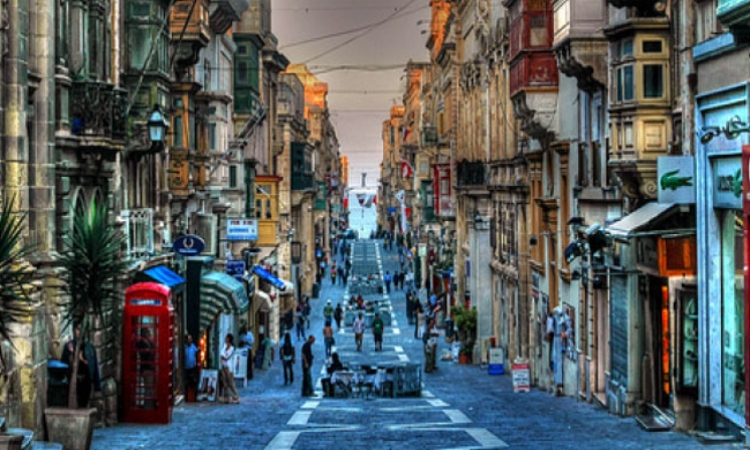This shopping street runs from the top to the bottom of Valletta, making it one of the capital’s longest thoroughfares. Prestigious establishments line the street, and it also hosts a daily street market. No casual strolling passers-by here but only throngs of shoppers. However, let us not omit to admire the numerous imposing houses, palaces, churches, that alternate with, and sometimes house, the more commercial enterprises. A walk down Merchants Street on a Sunday morning or early afternoon will allow its stately, dignified architecture to be appreciated.
From Castile Square, we pass the side flank of the Auberge de Castile, built in 1574 and given a new façade by Domenico Cachia in 1744. Surely this must be the handsomest of the Auberges which the Knights have left us.
Next door to this Auberge comes Palazzo Parisio, which now houses the Foreign Ministry. This palace was built for Monsignor Domenici Sciberras who died there in 1744.
Crossing Merchants Street from Palazzo Parisio, we face the Auberge d’Italie, built by Girolamo Cassar in 1574 and enlarged in 1683 by Gregorio Caraffa, whose bronze bust, flanked by divers arms and trophies, can be seen above the main door.
On the same side of the road, past the turning into Melita Street, is St James, the church of the Langue of Castile and León, built in 1710 by Giovanni Barbara. This church has a fine titular painting by Filippo Paladini who was active in Malta from 1590 to 1595.
Further down Merchants Street, on the other side, are Casa Dorell, a large house of one of Malta’s noble families, and the Palazzo Castellania, now the Ministry of Health. This palace was built in 1757 to the order of Grand Master Pinto by the architect Francesco Zerafa.
The house where Grand Master La Vallette’s secretary, Sir Oliver Starkey, lived is to be found on the corner with St Lucia Street. Directly opposite is the Campo Santo, the cemetery which houses the remains of a number of knights who fell during the siege of 1565. The cross in the centre of the churchyard was erected there by Fra Flaminio Balbiani.
We cross the junction with St Lucia Street and come to the Public Registry, built by Grand Master Zondadari as the Palazzo di Città, also known as the Banca Giuratale. This imposing palace is where Napoleon spent the night of the 13th and 14th June 1798.
The building opposite housed the Monte di Pietà, which was established in 1598. Prior to this, it had also served as the Banca Giuratale.
The Order’s Cappellania – the residence of the Conventual Chaplains – stands on the Old Theatre Street corner. It was built to replace Casa Bellotti, and for this reason, it is still known by this name.
The Jesuits’ church, “tal-Ġiżwiti”, on the corner of Merchants and Archbishop Streets, is one of the loveliest in Valletta. It was built by Francesco Buonamico in 1596. The handsome building abutting the church was the original site of the University that was founded by the Jesuits in 1592.
Two imposing houses can be found a little further down Merchants Street on the opposite side of the road: Casa Zoitana and Casa Albergotti. At one time, they were owned by the eminent Greek philanthropist Niccolò Papaffy who also resided in one of them. Papaffy is remembered for his sterling work in assisting many Maltese youths to emigrate in search of a better life in other countries.
Casa Roselli Massa, with the Roselli Massa arms magnificently adorning the roof cornice, stands on the corner of Merchants and St Christopher Streets.
Further down, on the corner with St Dominic Street, is the parish church of Porto Salvo (“San Duminku”), built in the early 19th century on the site of an earlier church. Next to it, one finds St Nicholas (“tal-Erwieħ”), with its Mattia Preti titular painting.
At the bottom of Merchants Street, we find the Camerata, built in the 19th Century as a miltary barracks, on the site of the laundry of the Order. Even before this, there stood a novitiate for aspiring Knights of the Order. The nearby little Church of St Mary Magdalene administered a home for abandoned or fallen young women.
Many other important buildings in this street fell victims to enemy bombardments during the last world war. However, it is important that we can still appreciate those which have survived the savagery of armed conflict.
